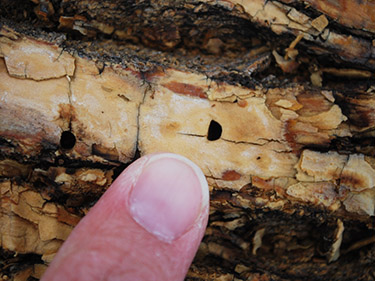
FORT COLLINS, Colo. – With a recent increase in media coverage, advertisements and tree-care company treatment recommendations related to emerald ash borer (EAB) – a highly destructive, non-native insect that kills all true ash trees – Colorado experts want to be sure consumers are receiving accurate information about the pest and its management. EAB is responsible for the death of tens of millions of ash trees in 30 states, and has become a concern for Colorado communities since its initial 2013 detection in Boulder, as 15 percent or more of all urban and community trees in the state are ash.
“While we can tell you definitively where EAB is known to be in Colorado, and where treatments of high-value, healthy ash are now necessary, it’s impossible to tell you where EAB isn’t located,” said Laura Pottorff, plant-pest quarantine manager for the Colorado Department of Agriculture and lead member of the Colorado Emerald Ash Borer Response Team.
She says uncertainty about the possible extent of EAB infestation is due to the difficulty in detecting the pest, which can infest an ash tree for up to four years before visible signs of decline occur in the tree. In Colorado, this pest has only been detected in Boulder County, but some municipalities outside the county have been actively managing for EAB – including chemically treating ash trees – for years. And this is for good reason: Entomologists expect EAB to eventually spread to all of northeast Colorado, and likely farther.
“It’s critical that municipal forestry departments begin managing for EAB in advance of its arrival, because they may have thousands of trees to care for,” said Keith Wood, community forestry program manager for the Colorado State Forest Service. “But this does not necessarily mean homeowners in these same areas should already be applying chemical treatments. The decision whether and when to treat individual ash trees is a personal preference, and should consider both costs and benefits.”
For homeowners who live outside of a known infested area (i.e., outside of Boulder County), and who are dealing with only one or a few ash trees on their properties, the Colorado EAB Response Team offers the following advice and considerations:
- Chemically treating trees likely is unnecessary at this time, as money may be better spent elsewhere. Other management strategies for dealing with EAB include removing or replacing ash trees before the pest’s arrival, and planting diverse new tree species in an effort to get them established now.
- Homeowners should consider the monetary and environmental costs associated with chemical treatments, and whether it makes sense to begin these treatments before EAB has actually been confirmed in their area.
- The removal and replacement of small or unhealthy ash trees offers more certain long-term benefits than paying for pre-emptive chemical treatments in areas where EAB has not yet been detected.
- The decision regarding whether to chemically treat individual ash trees is not based solely on whether EAB has been detected in an area. Large, high-value, healthy trees may warrant early treatments as “insurance” much more than young, unhealthy or poorly located trees, which instead may not ever warrant treatments.
- EAB treatments exist that are capable of helping infested trees recover, if applied early in an infestation, which may make delaying treatments a good choice if EAB has not been detected nearby.
- All Colorado homeowners should be determining if they have any ash trees on their property; if they do, they should start watching them for EAB symptoms that include branch dieback near the top, D-shaped exit holes 1/8-inch wide, serpentine tunnels under the bark and new sprouts on the trunk and branches.
To help Colorado homeowners identify ash trees susceptible to the pest, last month the Colorado State Forest Service and Colorado State University Extension released a free app for mobile devices. The EAB/Ash Tree ID app can be downloaded on almost any modern Apple or Android-based device, and easily located in app stores by simply searching for “ash tree.”
For more information about ash tree identification, the symptoms of EAB and treatment options, go to csfs.colostate.edu/emerald-ash-borer. For current information about EAB in Colorado and EAB quarantine information, visit www.eabcolorado.com.
EAB: What Coloradans Need to Know

Learn how to identify true ash trees:
- Compound leaves with 5 to 9 leaflets
- Leaflets, buds and branches growing directly opposite from one another
- Diamond-shaped bark ridges on mature trees
Know the signs of EAB infestation in ash trees:
- Thinning of leaves and upper branches and twigs
- Serpentine tunnels produced by larvae under the bark
- D-shaped exit holes 1/8-inch wide
- New sprouts on the tree trunk and branches
- Vertical splits in the bark
Multiple EAB management strategies exist for homeowners and communities, including removing and/or replacing ash trees, protecting trees with insecticides and planting different species of trees nearby to get them established before the arrival of EAB.
If hiring someone to apply pesticide treatments to protect ash trees, the applicator must be licensed by the Colorado Department of Agriculture as a Commercial Pesticide Applicator.
Never transport firewood or other products from ash trees, as this is the most likely method of accidental spread. A quarantine is now in place in Boulder County and surrounding areas to try and prevent the human-assisted spread of EAB.
If you think you have detected EAB in your ash trees, please contact the Colorado Department of Agriculture at 888-248-5535 or email CAPS.program@state.co.us.
The Colorado EAB Response Team is comprised of members from the following agencies/organizations: Boulder County, City of Boulder, Colorado Department of Agriculture, Colorado State Forest Service, Colorado State University Extension, Colorado Tree Coalition, Green Industries of Colorado, University of Colorado, USDA Animal and Plant Health Inspection Service and various Front Range municipalities.

